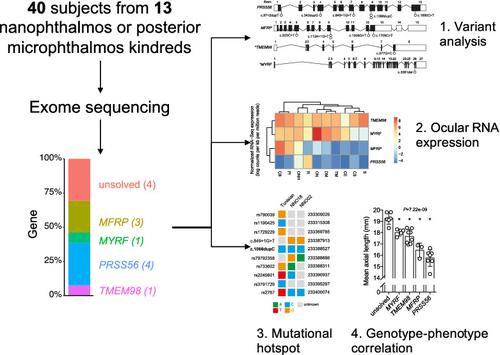当前位置:
X-MOL 学术
›
Clin. Genet.
›
论文详情
Our official English website, www.x-mol.net, welcomes your
feedback! (Note: you will need to create a separate account there.)
The genetic and clinical landscape of nanophthalmos and posterior microphthalmos in an Australian cohort.
Clinical Genetics ( IF 2.9 ) Pub Date : 2020-03-05 , DOI: 10.1111/cge.13722 Owen M Siggs 1 , Mona S Awadalla 1 , Emmanuelle Souzeau 1 , Sandra E Staffieri 2, 3, 4 , Lisa S Kearns 2 , Kate Laurie 1 , Abraham Kuot 1 , Ayub Qassim 1 , Thomas L Edwards 2 , Michael A Coote 2 , Erica Mancel 5 , Mark J Walland 6 , Joanne Dondey 6 , Anna Galanopoulous 7 , Robert J Casson 7 , Richard A Mills 1 , Daniel G MacArthur 8, 9 , Jonathan B Ruddle 2, 3, 4 , Kathryn P Burdon 1, 10 , Jamie E Craig 1
Clinical Genetics ( IF 2.9 ) Pub Date : 2020-03-05 , DOI: 10.1111/cge.13722 Owen M Siggs 1 , Mona S Awadalla 1 , Emmanuelle Souzeau 1 , Sandra E Staffieri 2, 3, 4 , Lisa S Kearns 2 , Kate Laurie 1 , Abraham Kuot 1 , Ayub Qassim 1 , Thomas L Edwards 2 , Michael A Coote 2 , Erica Mancel 5 , Mark J Walland 6 , Joanne Dondey 6 , Anna Galanopoulous 7 , Robert J Casson 7 , Richard A Mills 1 , Daniel G MacArthur 8, 9 , Jonathan B Ruddle 2, 3, 4 , Kathryn P Burdon 1, 10 , Jamie E Craig 1
Affiliation

|
Nanophthalmos and posterior microphthalmos are ocular abnormalities in which both eyes are abnormally small, and typically associated with extreme hyperopia. We recruited 40 individuals from 13 kindreds with nanophthalmos or posterior microphthalmos, with 12 probands subjected to exome sequencing. Nine probands (69.2%) were assigned a genetic diagnosis, with variants in MYRF, TMEM98, MFRP, and PRSS56. Two of four PRSS56 families harbored the previously described c.1066dupC variant implicated in over half of all reported PRSS56 kindreds, with different surrounding haplotypes in each family suggesting a mutational hotspot. Individuals with a genetic diagnosis had shorter mean axial lengths and higher hyperopia than those without, with recessive forms associated with the most extreme phenotypes. These findings detail the genetic architecture of nanophthalmos and posterior microphthalmos in a cohort of predominantly European ancestry, their relative clinical phenotypes, and highlight the shared genetic architecture of rare and common disorders of refractive error.
中文翻译:

澳大利亚队列中纳米眼和后眼的遗传和临床研究
纳米眼和小眼后眼是眼异常,其中两只眼睛异常小,通常与极端远视有关。我们从13个亲戚中招募了40名纳米眼或后眼部微眼,其中12名先证者接受了外显子组测序。9名先证者(69.2%)被分配为遗传诊断,其MYRF,TMEM98,MFRP和PRSS56变异。四个PRSS56家族中的两个带有先前描述的c.1066dupC变体,涉及所有报告的PRSS56亲属的一半以上,每个家族中周围的单倍型不同,表明存在突变热点。具有遗传学诊断的个体与没有遗传学诊断的个体相比,平均轴向长度较短,远视度数较高,其隐性形式与最极端的表型有关。
更新日期:2020-04-22
中文翻译:

澳大利亚队列中纳米眼和后眼的遗传和临床研究
纳米眼和小眼后眼是眼异常,其中两只眼睛异常小,通常与极端远视有关。我们从13个亲戚中招募了40名纳米眼或后眼部微眼,其中12名先证者接受了外显子组测序。9名先证者(69.2%)被分配为遗传诊断,其MYRF,TMEM98,MFRP和PRSS56变异。四个PRSS56家族中的两个带有先前描述的c.1066dupC变体,涉及所有报告的PRSS56亲属的一半以上,每个家族中周围的单倍型不同,表明存在突变热点。具有遗传学诊断的个体与没有遗传学诊断的个体相比,平均轴向长度较短,远视度数较高,其隐性形式与最极端的表型有关。









































 京公网安备 11010802027423号
京公网安备 11010802027423号